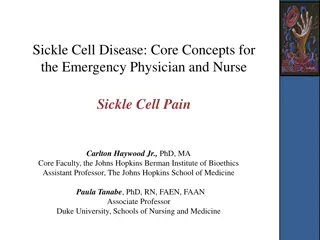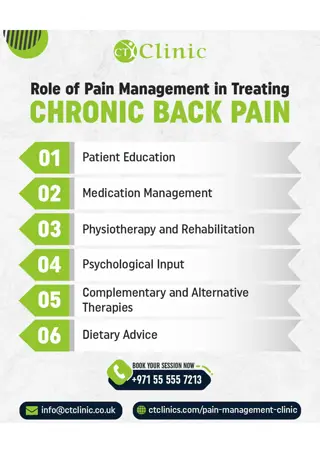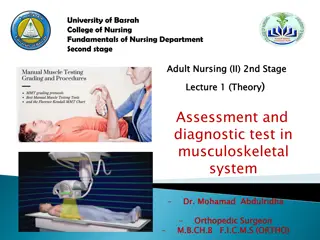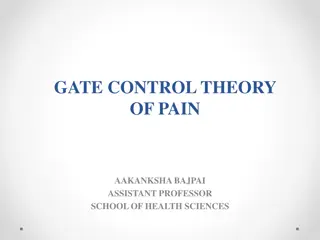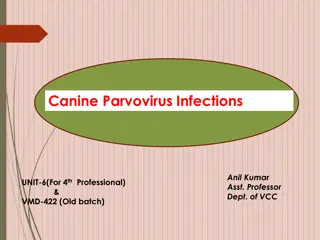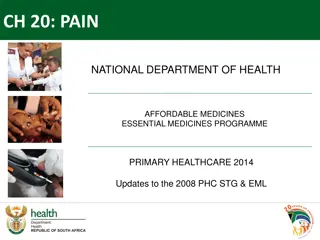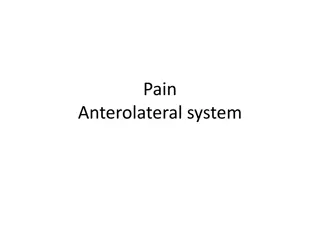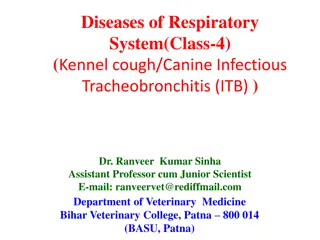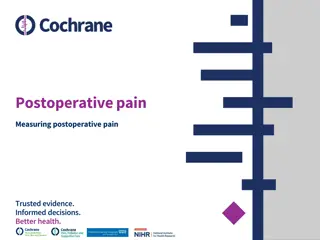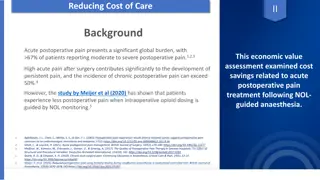Challenges in Canine OA Pain Management
The Canine OA Pain Management market faces major gaps in joint replacement, high risk for older pets, daily drug reliance, and inadequate treatment options. Synovial macrophages play a key role in driving destructive responses in osteoarthritis. Radiosynoviorthesis offers a potential solution with proven safety in canine elbows.
Download Presentation

Please find below an Image/Link to download the presentation.
The content on the website is provided AS IS for your information and personal use only. It may not be sold, licensed, or shared on other websites without obtaining consent from the author.If you encounter any issues during the download, it is possible that the publisher has removed the file from their server.
You are allowed to download the files provided on this website for personal or commercial use, subject to the condition that they are used lawfully. All files are the property of their respective owners.
The content on the website is provided AS IS for your information and personal use only. It may not be sold, licensed, or shared on other websites without obtaining consent from the author.
E N D
Presentation Transcript
Canine OA Pain Management Market: 2 Major Gaps 2 Major Gaps Joint Replacement Not for all joints High risk for older pets Disruptive rehab Daily Drugs Therapeutic Gap No durable, proven intermediate treatment options Ineffective for many Long-term safety issues Poor compliance $4.2B Veterinary Revenue Gap ~2M cases / year referred only ~0.6M treated General Practices Specialty Hospitals 2 1Harmony Marketing Partners survey results, 2016
OA and Synovial Macrophages The role of synovial macrophages and macrophage-produced cytokines in driving aggrecanases, matrix metalloproteinases, and other destructive and inflammatory responses in osteoarthritis Bondeson J, Wainwright SD, Lauder S, et. al. Arthritis Research & Therapy 7 2006 8:R187(doi:10.1.186/ar2099) Synovial inflammation is implicated in many signs and symptoms of OA, including joint swelling and effusion In the osteoarthritis synovium, both inflammatory and destructive responses are dependent largely on macrophages and these effects are cytokine driven through a combination of IL-1 and TNF These cytokines can stimulate their own production and induce synovial cells and chondrocytes to produce IL-6, IL-8, leukocyte inhibitory factor; as well as stimulate protease (matrix metalloproteinases (MMPs) and aggrecanases) and prostaglandin production Results suggest prioritization of attempts to modify macrophage function in OA, with the aim of decreasing both inflammatory synovitis and the production of degradative enzymes (cytokines) of importance for the progression of the disease 3
Radiosynoviortheses What is radiosynoviorthesis (RSO)? Intra-articular injection of radioisotope (radionuclide) to treat joint inflammation Mode of action: Radionuclide is absorbed by synoviocytes and phagocytized by macrophages within the synovium resulting in apoptosis and non-inflammatory ablation of inflammatory cells The homogeneous tin colloid suspension (1.5 20 m) of tin-117m emits discrete (0.3 mm radiation range), low-energy conversion electron radiation The colloid containing micro particles is retained in the canine joint space for at least 42 days (3 half-lives) Mechanism of cell death from Synovetin OA is from extended duration (T1/2 = 14d) low energy radiation (<158 keV) exposure effects 4
How Safe is in Canines? Cumulatively 100 elbows of 75 dogs injected Examined multiple times post-treatment over 12 months PE, CBC, Chem screen, UA, Joint fluid, lameness, range of motion, limb circumference, force plate, MRI, PET, CT, radiographs, Brief Pain Inventory, Colorado chronic pain scoring, concomitant meds, radiation, scintigraphy modalities were used 3 sites LSU, MU veterinary schools and Gulf Coast Veterinary Specialists in Houston No safety associated parameters fell outside of expected norms (including a mis-administration) 5
Clinical Studies Trialing Canine Study name Study Number None assigned by University of Missouri None assigned by University of Missouri Date Injected March 31, 2015 to May 15, 2015 October 14, 2015 to last dog evaluated Feb. 27, 2017 Number Evaluated 5 (5 elbows) Site 5 normal dog safety study University of Missouri College of Veterinary Medicine, J. Lattimer DVM, DACVR Gulf Coast Veterinary Specialists, M. Fabiani, DVM, DACVR; C. Hudson DVM, DACVS, B. Beale DVM, DACVS Louisiana State University School of Veterinary Medicine, K. Aulakh, DVM, DACVS University of Missouri College of Veterinary Medicine, J. Lattimer DVM, DACVR GCVS, Houston, TX LSU-SVM, Baton Rouge, LA Grade 1 & 2 elbow OA client dog study 44 (46 elbows) Grade 3 elbow OA client dog study C-22017 June 21, 2017 to July 26, 2017 15 (27 elbows) Re-injection of 117m Sn colloid (Synovetin OA) in grade 1 or 2 client dog study C - 80817 September 11, 2017 to October 13, 2017 10 (20 elbows) LSU-SVM, Baton Rouge, LA MU-CVM, Columbia, MO Studies C-22017 and C-80817 are GMP, GCP and GDP pivotal studies validating commercially produced Synovetin OA and the commercial manufacturing process utilizing Theragenics, Inc. a human medical radioisotope manufacturer based in Buford, GA (NE of Atlanta) 6
How Effective is ? Canine Brief Pain Inventory Client survey about reduction in pain and level of activity Each time point survey compared to baseline survey results 37 dogs initially treated with the label dose of Synovetin OA 3 month results 15/37 (40%) both pain AND level of activity improved successfully (conventional cBPI success) 24/37 (65%) one OR other improved successfully with NO worsening of the other (client success) 6 month results 14/35 (40%) both pain AND level of activity improved successfully 24/35 (69%) pain OR level activity improved successfully with NO worsening of the other 7
How Effective is ? Canine Brief Pain Inventory Client survey about reduction in pain and level of activity Each time point survey compared to baseline survey results 37 dogs initially treated with the label dose of Synovetin OA 9 months results 20/32 (62%) both pain AND level of activity improved successfully 25/32 (78%) one OR other improved successfully with NO worsening of the other 12 months results 16/31 (52%) both pain AND level of activity improved successfully 24/31 (77%) one OR other improved successfully with NO worsening of the other 8
How Effective is ? Force plate analysis of Grade 1 or 2 elbow OA (single leg injection) 22 dogs with grade 1 or 2 elbow OA in which the most painful elbow was injected > 5% positive change in PVF or VI considered a successful treatment effect Each dog served as its own control comparing each time point to initial baseline data 3 different dosages (1.0, 1.75 and 2.5 mCi per joint for 50 lb. dog) 18/22 (82%) treatment effect at one or more time points 1 month 9/22 (41%) treatment success 3 months 13/22 (59%) treatment success 6 months 13/21 (62%) treatment success 9 months 11/18 (61%) treatment success 12 months 4/13 (31%) treatment success 9
How Effective is ? Force plate analysis of Grade 1 or 2 elbow OA (elbow reinjection ) 10 dogs with grade 1 or 2 elbow OA in which both affected elbows were injected > 5% positive change in PVF or VI considered a successful treatment effect Each dog served as its own control comparing each time point to initial baseline data Label dosed (1.75 mCi per joint in a 50 lb. dog) Baseline, 3 and 6 month force plate evaluations only 6/9 (67%) treatment effect at one or more time points 3 months 5/9 (56%) treatment success 6 months 6/9 (67%) treatment success 10
How Effective is ? Clinicians lameness assessment (single leg injected) Lameness grading from 0 5 (worst) Evaluated at walk and trot before and after joint manipulation Each dog served as its own control comparing each time point to initial baseline data 34 dogs in the Per Protocol group 3 different dosages (1.0, 1.75 and 2.5 mCi per joint for 50 lb. dog) 9 months changes from baseline, indicating improvement from baseline, were found to be statistically significant (n=18) 12 months changes from baseline, indicating improvement from baseline, were found to be statistically significant (n=19) McNemars test the comparison of cBPI success to clinician-assessed lameness success comparing baseline to each visit indicated statistical agreement. 11
Mykonos Experience With Mykonos, 1.5 year old, castrated male, 88 lb. German Shephard, bilateral ununited anconeal prs. Right elbow injected with label dose 10/14/15 Left elbow injected with label dose 9/20/16 Both elbows injected with label dose 12/18/17 Baseline2 cBPI scoring Baseline 1 mos. 3 mos. 6 mos. 9 mos. 1 mos. 3 mos. Date 10/13/15 11/10/15 1/7/16 4/1/16 7/7/16 9/19/16 10/26/16 12/15/16 Pain Severity Score (Q 1-4) 6.25 2.00 0.75 0.00 0.00 6.00 0.00 0.00 Pain Interference Score (Q 5-10) 2.17 0.83 0.00 0.33 0.00 7.17 0.00 0.00 Quality of Life Score (Q 11) Good Very Good Very Good Excellent Excellent Poor Excellent Excellent Baseline prior to left elbow injected Baseline2 prior to right elbow injected 12
Mykonos Experience With Mykonos, 1.5 year old, castrated male, 88 lb. German Shephard, bilateral ununited anconeal prs. Right elbow injected with label dose 10/14/15 Left elbow injected with label dose 9/20/16 Both elbows injected with label dose 12/18/17 Baseline3 6 mos. 9 mos. 12 mos. 3 mos. 6 mos. 9 mos. 12 mos. Date 3/23/17 6/22/17 9/21/17 12/17/17 5/4/18 7/6/18 9/21/18 12/30/18 Pain Severity Score (Q 1-4) 0.00 0.00 0.00 0.75 0.00 0.00 0.00 0.00 Pain Interference Score (Q 5-10) 0.00 0.00 0.00 0.67 0.00 0.00 0.00 0.00 Quality of Life Score (Q 11) Excellent Excellent Excellent Very Good Excellent Excellent Excellent Excellent Baseline3 prior to both elbows injected 13
Summary Tin-117m is a radiotherapeuticdevicewith a unique mode of action that targets inflammatory cells which incite multiple inflammatory cytokinetic cascades. This device not only reduces pain, but also alters the progression of arthritis; hence, disease modifying . ( disease modifying is intuitive based on mode of action; however, must be clinically validated in dogs) Due to its unique mode of action, tin-117m is not associated with the historical adverse drug events seen with NSAIDs: gastrointestinal, renal, platelet and hepatic Tin-117m provides veterinary specialty clinics another revenue stream through addressing arthritic dogs refractive to general standard of care treatments 15
Studies in dogs with cranial cruciate ligament (CrCL) deficiency and rupture... Evidence of Pre-Radiographic Synovitis >$1.32B/year is spent on ACL disease in the US (JAVMA 2005,227:1604-1607) Synovitis is an early feature of arthropathy in dogs with minimally detectable damage Sources: Klocke NW, et al. Am J Vet Res. 2005;66:493-499; Doom M, et al. Vet Immunol Immunopathol. 2008;125:143-161; Bleedorn JA, et al. Vet Surg. 2011;40:531-543.
Next Steps Clinical Experience program: Convetra is recruiting 10 specialty hospitals to introduce Synovetin OA Profile of specialty hospital candidate Surgeon(s) with an interest in sports medicine and rehabilitation Gait analytics Perform arthroscopy Hospital has an existing RAM license (I-131 or Technetium) Radiologist interested in nuc med Searchable patient data base Convetra will: Provide Synovetin OA to treat 3 dogs with elbow OA Support amending RAM license to add tin 117m Train RSO and Authorized Users Figure: Canine elbow IA injection of tin-117m 17
Thank you 18



